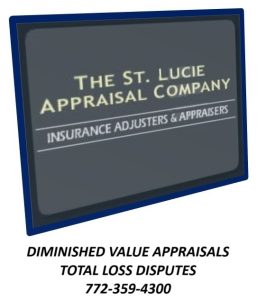At The St. Lucie Appraisal Company and AUTODIMINISHEDVALUE.COM our inherent diminished value reports are ultimately designed to be read and decided upon by a magistrate or mediator. In the past, our reports have proved conclusive in winning cases for our customers because they are based on real-world data.
There are only seven methods in which diminished value can be calculated.
1. A Letter from the Claimant’s Dealership
A letter from the claimant’s dealership declaring that the vehicle has lost value as a result of undergoing collision repairs. A typical insurance company response: “A dealership is not a disinterested third party and has a financial interest in the acquisition price of a trade in vehicle. Their business model is to buy low and sell high. An offer of trade is simply the starting point of a negotiation and does not, in and of itself, establish any specific loss in value. It is our position that the documentation presented by you does not provide any underlying market data in support of the post-accident value of your vehicle.” One may concede that the use of a trade-in quote from the claimant’s dealer presents a valid argument that this is not an acceptable method. Your dealer’s profit motive disqualifies this methodology.
2. Unsubstantiated Expert Opinions
Some methods rely on unsubstantiated estimates, usually buttressed by an appraiser’s assertion that they are based on his or her years of experience in the field. A lack of any substantial evidence disqualifies this methodology.
3. Formulas and Algorithms
By using formulas or algorithms such as Rule 17c which assigns modifiers (points) to things such as whether frame/unibody damage or air bag deployment occurred or whether adjacent panels needed to be painted. These types of reports may be influenced by client preferences, can be tailored to achieve specific results and should be considered theoretical calculations. These appraisals can be complex and difficult to interpret, even for legal professionals. Judges and juries may find these appraisals challenging to understand. These methodologies may be vulnerable to manipulation, that can affect their reliability which disqualifies these methodologies.
4. Automobile Auction Results
The use of automobile auction results, while proving a better method that the formulaic approach, have been deemed too generic by insurers. These results will show a number of similar vehicles that were sold at auction, some that were never damaged and others with repair histories. You can see that the bad Carfax vehicles sold for less but the auction printouts don’t show the mileage, options, colors, etc. of each vehicle nor do they list the extent of the damages that were repaired. Insurance companies will argue that these results do not apply to your car and the circumstances of the case being heard – your vehicle and the damages that were repaired. Also, the automobile auction market is not the market you are in which disqualifies that methodology.
5. Difference Between NADA or KBB Values based on Conditions
A deduction based on the difference between NADA or KBB Values. Basing diminished value calculations on NADA or KBB values alone may not provide a complete picture, as it doesn’t incorporate real-world market data or dealer insights. The absence of real-world data disqualifies this method.
6. Improper Use of Carfax.com and Other Retail Ads
An appraisal showing random screenshots of similar cars for sale, some of which were previously repaired, to make comparisons. Typically, very little information about the cars, such as a description of the repairs that were done, is provided. These are “asking prices” rather than “sold prices” There is no database of sold vehicles. This method invites “cherry-picking” of higher or lower-priced cars, rendering it fundamentally flawed and disqualified.
7. The St. Lucie Appraisal Company Methodology
The diminished value reports that are prepared by The St. Lucie Appraisal Company and AUTODIMINISHEDVALUE.COM take into consideration all the specifics of your car as well as the exact amount and nature of the damages that were repaired. It is as comprehensive a diminished value report as you can find. Our report contains our own opinion which is confirmed by the opinions of six sales managers at recognized dealerships in your area. The last paragraph of our report addresses insurance company concerns regarding the use of dealer quotes. It reads: “All of the dealers queried were informed that the subject vehicle was not available for purchase or trade, therefore none of the dealers queried had any vested interest in the subject vehicle. This collaborative method represents unbiased, irrefutable proof of the evidence and approximate amount of inherent diminished value.”
